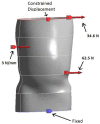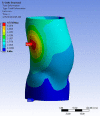Comparison of biomechanical behavior between a cast material torso jacket and a polyethylene based jacket
- PMID: 25815054
- PMCID: PMC4331733
- DOI: 10.1186/1748-7161-10-S2-S15
Comparison of biomechanical behavior between a cast material torso jacket and a polyethylene based jacket
Abstract
Background: Numerous designs are used to the treatment of Early Onset Scoliosis. For example, a Thoraco-Lumbo-Sacral Orthosis (TLSO) is constructed using Polyethylene (PE). In addition, a series of castings has been implemented using cast material (3M, BSN Medical). The cast material has some significant advantages over the PE design including: growth preserving, improved compliance, decreased invasiveness, delaying or avoiding surgery, and the ability to allow the skin to breathe. However, the mechanical effectiveness of the cast material brace as compared to the TLSO is unknown, thus providing the objective of this study.
Methods: A total of 23 standardized tensile tests were performed on the Delta-Cast Soft(®) and 3M(TM) Scotchcast(TM) Plus Casting Tape in order to obtain mechanical properties (Young's and shear moduli and Poisson ratios). Using a radiograph of a thoracic spine, the size of twelve vertebrae and eleven intervertebral discs were measured and used to create a finite element spine model. Simulations using this model were used to establish mechanical loads which were then applied to finite element models of the TLSO and cast jacket. The thicknesses and number of material layers was varied in these models. Multiple simulations were performed.
Results: It was found that a 6.6.mm thick cast jacket made of Delta-Cast Soft(®) had a maximum deformation of 4.7 mm, a maximum stress of 2.9 MPa and a structural factor of safety of 5.71. On the other hand, a 4 mm thick jacket made of PE had a maximum deformation of 2 mm, a maximum stress of 8.9 MPa and a structural factor of safety of 2.70. The cast jacket was 3.5 times lighter and had a material of cost 1/5 of the PE brace.
Conclusions: Based on the results, either design will generate the proper constraint forces to maintain spinal correction. But, based on the design parameters (thickness, mechanical properties, structural factor of safety and cost) the brace made of cast material, though slightly thicker has superior structural and cost benefits. Thus, from the biomechanical point of view, the cast brace is more efficient than the PE brace.
Keywords: Cast; Early onset Scoliosis; TLSO; brace design.
Figures




References
-
- Daniel IM, Ishai O. Engineering Mechanics of Composite Materials. Oxford University Press. New York, NY; 2006.
-
- Villemure I, Aubin CE, Dansereau J. Simulation of Progressive Deformities in AIS using Biomechanical Model Integrating Vertebral Growth Modulation. J. of Biomechanical Engineering. 2002;124(2):784–790. - PubMed
LinkOut - more resources
Full Text Sources
Miscellaneous

